It was first chosen as the best public library in the world, and has just won the 2024 Mies van der Rohe Prize for Contemporary Architecture from the European Union. It is the Gabriel García Márquez Library of Barcelona, an architectural and sociological jewel located in the … popular district of San Martín and which already competes with other of the many architectural landmarks of Barcelona. This marvel is a project by SUMA Arquitectura, the Madrid studio led by Elena Orte and Guillermo Sevillano.
The French architect Fréderic Druot chaired the jury that awarded the ‘Gaboteca’, as some call it, which highlights in its ruling how the building “acts at the scale of the city, contributing to the transformation of the neighborhood, opening up as a new public space exterior and interior.
Library facade.
M. Lorenci
The ruling also highlighted the “meticulous attention to details” of the functional building erected between the popular and populous neighborhoods of Sant Martí de Provençals and La Verneda, far from the heart of the city, Las Ramblas or the Gothic quarter, always crowded with tourists. It has energized and changed the architectural face of a working-class social housing neighborhood of late Fanquista developmentalism. At its scale, it has had the same effect on the neighborhood as the Guggenheim in Bilbao.
You have to leave the Sagrada Familia circuit, Park Güell, La Pedrera or the more modern Glòries tower by Jean Nouvel to reach the library. But just as buses with Japanese tourists stop at these places, there are those that arrive at the ‘Gaboteca’, a new icon with cubic volumes on the outside. The ‘bibliotourists’ walk through its bright rooms shared by students and retirees to make videos that they joyfully upload to Tik Tok or Instagram.
full
Its occupancy level is in line with the quality and attractiveness of its facilities. A constant and massive attendance from the day it opened, which generated enthusiasm in a working-class neighborhood “that had been waiting for something like this for years,” according to Sevillano.
Young users on one of the six floors of the library.
M. Lorenci
The architects wanted to create “an urban living room” without the slightest solemnity. They were very aware of the demands of a library in the digital age, with the majority of its young users armed with computers and mobile phones, who demand sound and image workshops. It has a newspaper library, a Macondo radio studio, meeting and leisure areas for more relaxed reading with a ‘chill out’ atmosphere, carpeted corners, armchairs, hanging armchairs, poufs, hammocks that are highly sought after to lie down and read, and wooden steps in the area. childish.
Wood is the primary material of the cozy, bright and comfortable building of 4,000 square meters on six levels and with popular DNA. Its structure evokes a disorderly pile of books and the large stained glass windows allow light to pour in, with a feeling of greater spaciousness inside than outside. Its designers present it as a ‘Palace for the People’, according to sociologist Eric Klinenberg’s definition for public facilities or spaces that, in addition to specific functions (culture, health, education, leisure…) are infrastructures of proximity and cohesion. social.
difficult birth
Work began in 2019 on a nondescript plot of land between Concilio de Trento and Treball streets. Its birth was “a difficult birth,” say the architects, who in the middle of the pandemic worked on the project from Madrid, 700 kilometers away, and with the consequent logistical crisis that tormented suppliers and builders.
The stairs connect the open spaces of the building.
SUMA Architecture
Opening in May 2022, the rewards would soon make you forget the difficulties. In August 2023 it became the best library in the world, and at the end of the year it won the FAD Prize for Architecture and Interior Design, to which is now added the Mies van de Rohe prize. They have already called it ‘the Guggenheim of La Verneda’ in reference to the neighborhood forgotten by the administrations and that the new space for culture has revitalized.
A bust of Gabriel García Márquez presides over the space dedicated to the Colombian writer and 1982 Nobel Prize winner, who lived in Barcelona between 1967 and 1975, although he did so in the wealthy and distant neighborhood of Sarriá. “Life is not what one lived, but what one remembers and how one remembers it to tell it,” reads the façade of the library. It is a passage from ‘Living to tell it’, de Gabo’s memoirs.
Space dedicated to the writer Gabriel García Marquez.
M. Lorenci
The International Federation of Library Associations and Institutions (IFLA) and Systematic chose it as the best public library of 2023 ahead of the Janez Vajkard Valvasor Krškov Public Library (Slovenia), the City of Parramatta Library (Australia) and the Shanghai Library East (China ).
For the first time, the prestigious award went to a library from southern Europe and a very small one, only 4,000 square meters compared to giants such as the Missoula Public Library (USA) with 10,000 meters, the Deichman Bjørvika (Norway) with 13,500 and the Oodi Helsinki Central Library (Finland) with 18,000, awarded in previous years.
Another of the library’s innovative spaces that opened in 2022.
M. Lorenci
The same jury awarded on Thursday the pavilion on the campus of the Technical University of Braunscheweig (Germany), the work of architects Gustav Düsing and Max Hacke, the 2024 Architecture Prize. Both works were selected from a list of 362 projects from 38 countries. The awards ceremony will take place on May 14 at the Mies van der Rohe Pavilion in Barcelona.





